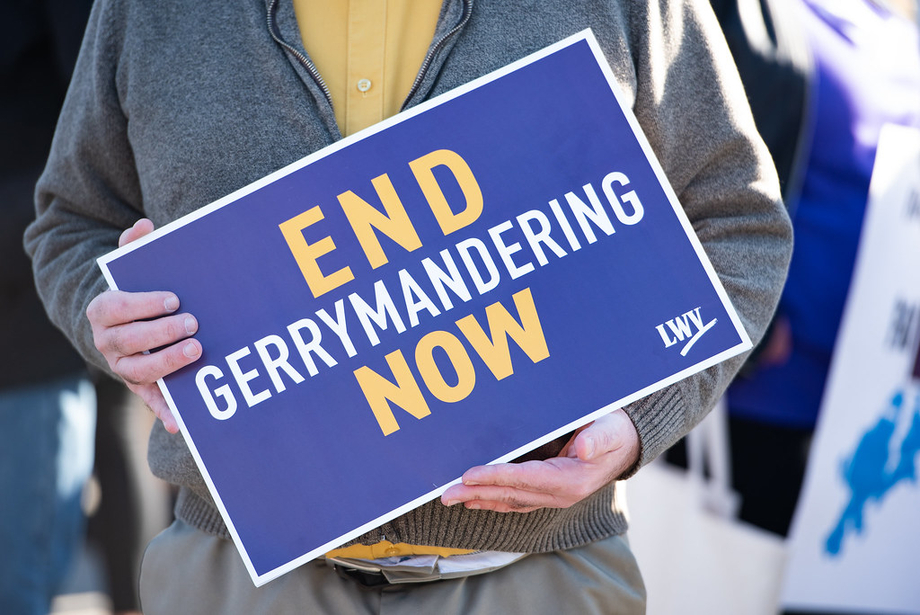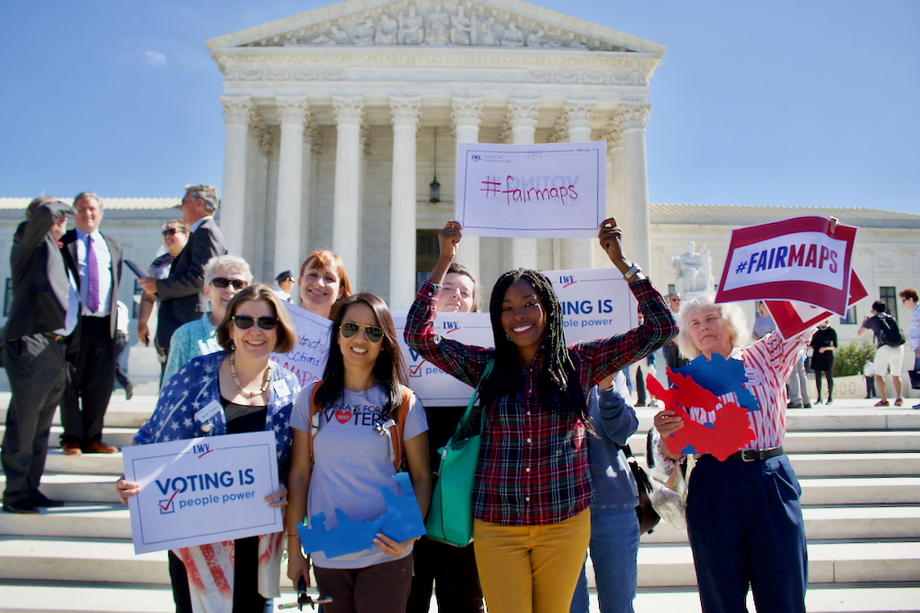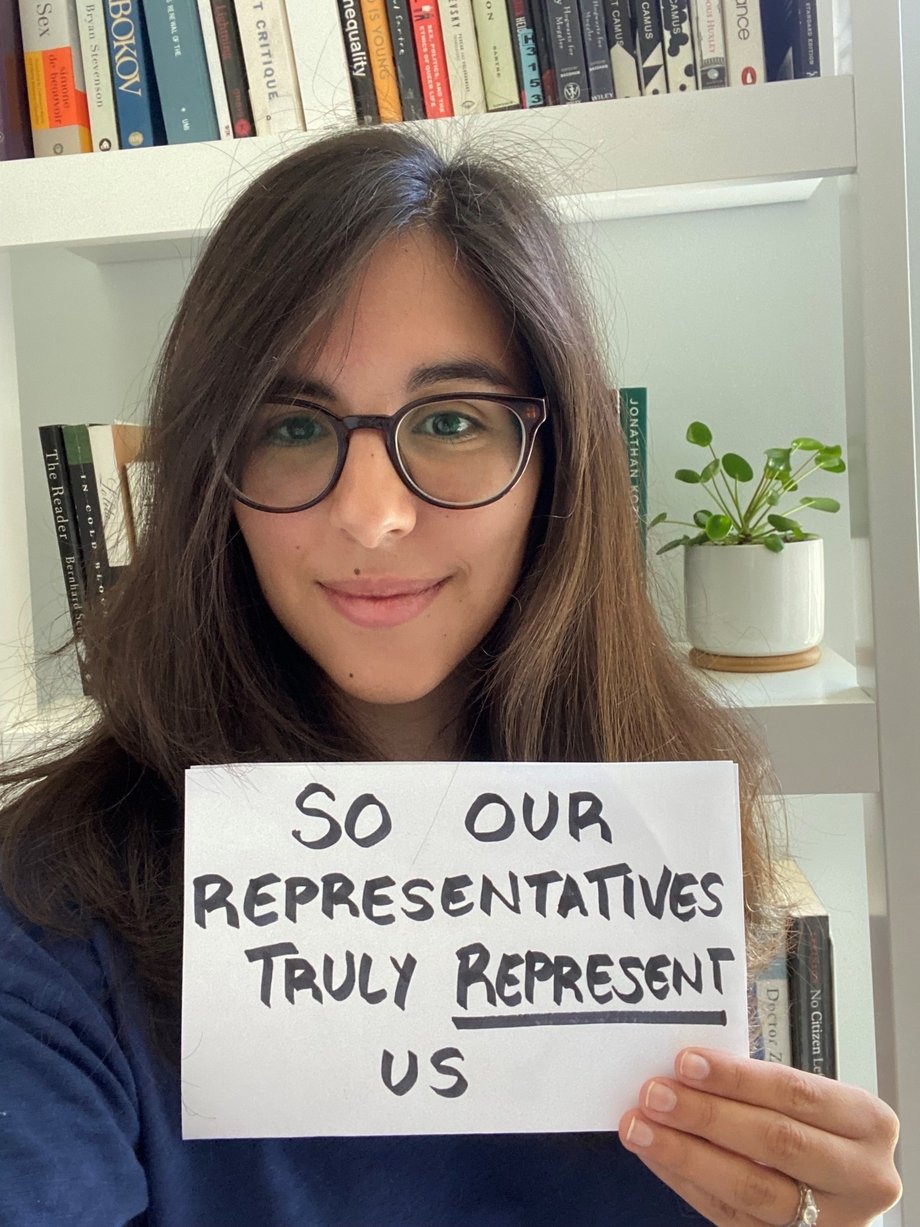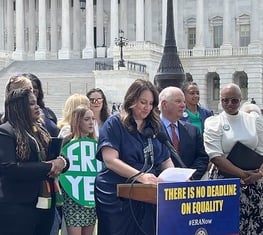What’s Happening with Alabama’s Redistricting Post-Milligan?
In an unexpected decision last June, Allen v. Milligan, the US Supreme Court (SCOTUS) upheld Section 2 of the Voting Rights Act of 1965 (VRA) and ruled that Alabama’s 2021 congressional map illegally diluted the voting power of Black Alabamians. This case is a crucial reaffirmation of the importance of VRA Section 2 and a win for voter equality.
But the Supreme Court’s decision wasn’t the end of the story. Following SCOTUS’s ruling, Alabama defied the court’s order in an attempt to continue disempowering Black residents. This blog explores what happened and where Alabama’s congressional districts are now.
Alabama’s Congressional Map Dilutes Black Voting Power
Alabama’s legislature drew its 2021 congressional map with only one majority-Black district, even though Black residents make up over a quarter (~27%) of Alabama’s total resident population. That meant that under the 2021 map, Black voters could only elect candidates of their choice in one of Alabama’s seven congressional districts.
A series created by the League of Women Voters of AL to explain redistricting in 2021.
Soon after the congressional map was passed in 2021, several voters and voting rights organizations sued. After an extensive presentation of evidence, a three-judge district court panel, which included two Trump appointees, found that the maps violated Section 2 of the VRA because they illegally diluted Black voting power. The district court ordered Alabama’s legislature to redraw the map to include two majority — or near-majority — Black districts to remedy the dilution of Black Alabamans’ votes. The district court ordered the map to be redrawn before the 2022 congressional elections.
Despite the map being struck down and the district court’s charge to redraw the maps, the Supreme Court put that ruling on hold for the 2022 elections under the theory that it was too close to the election to change the districts. Thus, voters were forced to vote under illegal maps that were purposely racially discriminatory in the 2022 election.
The Supreme Court Reviews Alabama’s Maps
The state of Alabama appealed the decision to the US Supreme Court and asked for the district court’s order to be paused during the appeal. The Supreme Court paused the order, allowing the illegal map to stay in place during the 2022 congressional election. This signaled to voting rights advocates and experts that the Supreme Court would likely uphold the bad map.
The Supreme Court heard oral argument on October 4, 2022. Voting rights advocates and experts feared the Supreme Court would further weaken the VRA by dismantling Section 2 and removing consideration of race from the equation. Yet, on June 8, 2023, the Supreme Court affirmed the district court’s ruling in a 5-4 decision written by Chief Justice Roberts, upholding Section 2 and requiring Alabama to draw two congressional districts where Black voters have an opportunity to elect a candidate of choice.
Alabama Disobeys the Supreme Court
After the Court's decision, the Alabama Legislature got to work drawing a new 2023 map that would comply with the district court’s orders, or so people thought. What emerged was total disregard for the court’s order.
For the second time in two years, the Alabama legislature drew a map that included only one majority-Black district, ignoring explicit instructions from the federal courts. Plaintiffs objected, and the three-judge panel rejected the map because it violated Section 2 of the VRA and failed to meet the requirements of its original ruling in Milligan.

The district court noted, “[w]e are deeply troubled that the State enacted a map that the State readily admits does not provide the remedy we said federal law requires.” The district court then assumed responsibility for drawing the map, removing the legislature from the process. This was a serious step, as state legislatures are usually provided significant authority in drawing remedial maps, even after a statutory or constitutional violation is found.
The district court appointed a special master to draw three proposed redistricting plans that complied with Section 2 of the Voting Rights Act and prevented the dilution of Black voting power.
Alabama Seeks SCOTUS Approval to Racially Discriminate
In the face of the district court’s rejection of its racially discriminatory map, the Alabama legislature appealed to the Supreme Court again. This was a legal "Hail Mary" for the legislature, as no underlying facts or law had changed since the Court's ruling. Nor was there reliable information that any of the justices in the majority had changed their mind, though. Justice Kavanaugh’s concurrence in Milligan was viewed as a potential opening for the legislature to reverse the original outcome. Specifically, Justice Kavanaugh noted that race-conscious remedial redistricting may not be allowed to continue indefinitely; to many, this looked like an opening to challenge the constitutionality of Section 2 in the future.
Support our work defending voters across the nation.
In its brief, Alabama argued that the district court ruling striking down its new plan “commanded that race come first and all other criteria come second.” It highlighted that only four of the nine justices agreed that race was not illegally used as the main factor in maps with two Black-majority or near-majority districts.
Unfortunately for the Alabama legislature — and fortunately for democracy — not one justice, including Justice Kavanaugh, voted to allow the state to ignore their ruling from two months earlier.
Supreme Court Rejects Alabama’s Second Attempt to Dilute Black Voting Power
On September 26, SCOTUS ended the Alabama legislature’s attempt to dilute Black political power through its congressional map by denying the state’s request to ignore the district court’s decision. This sent a clear message: you cannot ignore Supreme Court rulings or keep drawing unconstitutional maps.
Failure to comply with orders to draw nondiscriminatory districts lost the Alabama legislature the privilege of drawing its congressional map. Instead of intervening on the legislature’s behalf, the Supreme Court denied Alabama’s request for a stay and allowed the court to select from maps drawn by the special master for the 2024 election.
The entire debacle, however, was enabled by the Supreme Court’s gutting of Section 5 of the VRA in the 2013 case Shelby v. Holder. If Section 5 were still in effect, the Alabama legislature would have been required to submit the 2021 map under a preclearance system to ensure it did not harm Black voters before it went into effect. Instead, we had to go through all of this — multiple years in court, disregard for court orders, and Alabamians being represented under illegally racially diluted maps for two years. This case illustrates why our country still desperately needs Section 5 to protect voters of color.
In our current post-Shelby environment, this case is a win. As former Attorney General Eric Holder said after the Supreme Court denied Alabama’s appeal: “[t]hese shameful, odious efforts to diminish the rightful voting power of Black Alabamians have finally been defeated.”
The District Court Chooses a Map
Initially, there was uncertainty about which map would be used in the 2024 elections. Under looming time constraints, the three-judge panel was tasked with choosing which of the proposed remedial maps Alabama would use, with enough time to give election officials room to prepare before primaries in March 2024.
The special master submitted his three proposed maps to the panel on September 25. A hearing on the proposed maps took place on October 3, 2023.

The three plans each address the Section 2 violations found in the two prior maps drawn by the Alabama legislature. They each contained two congressional districts with majority- or near-majority-Black populations. All maps would include significantly higher Black Voting Age Populations (BVAP) in districts 2 and 7 than the previous BVAP in the challenged map. However, the plans varied:
Remedial Map 1
- Contains two majority-Black districts (congressional districts (CD) 2 & 7);
- Favored by Milligan plaintiffs because of the two majority-Black districts and the fact that it connects communities of interest in a logical manner.
Remedial Map 2
- Only one majority-Black district (CD 7);
- CD 2 is considered a Black-opportunity district, in which the Black population still has a strong opportunity to elect preferred candidates;
- Milligan plaintiffs objected due to the performance analysis for District 2, which had candidates of Black voters’ choice winning only 13/17 elections
Remedial Map 3
- Only one majority-Black district (CD 7) (BVAP of 51.9%);
- CD 2 is considered a Black-opportunity district (BVAP of 48.7%);
- Also favored by Milligan plaintiffs because it provided the best election outcome analysis with Black-preferred candidates winning 16/17 elections;
- Preserves Birmingham and Mobile in one district
- Preserved all 18 core counties in the Black Belt without splitting those counties
On October 5, 2023, the three-judge panel approved Remedial Map 3 for use in the 2024 election cycle. The Order explains that Map 3
“[S]atisfies all constitutional and statutory requirements while hewing as closely as reasonable to the Alabama Legislature’s 2023 Plan....[w]e must give the Alabama Legislature as much deference as possible, and we may not disturb the policy choices it made in the 2023 Plan any more than is necessary to remedy the likely Section Two violation we found.”
Alabama's secretary of state, Wes Allen, tweeted that his office will facilitate the 2024 election cycle based on the map the federal court “forced” upon Alabama but that “all Alabamians to know that the legal portion of this process has not yet been completed.” A trial before the same three-judge panel will take place in 2025.

Alabamians and voting rights advocates such as US Representative Terri Sewell, the ACLU of Alabama, the National Redistricting Foundation, and former Attorney General Eric Holder celebrated the decision.
LWVUS CEO Virginia Kase Solomón stated:
“Let this be the final lesson: legislatures and map drawers can no longer ignore the requirements of the VRA. Alabama repeatedly tried to harm its Black population by eliminating their political power. Today SCOTUS said no more. This is a win for democracy and all voters.”
For 2024, Alabama will proceed with the redistricting scheme approved by the panel of judges: Remedial Map 3.
Milligan’s Impact on Alabama, Black Voters, & Democracy
The Milligan case is an incredibly important win for Black Alabamians whose political power has historically been denied and diluted by the state. But its reach goes far beyond Alabama, impacting both voters across the country and democracy itself.
There are currently twelve states engaged in active Section 2 litigation over redistricting in the wake of the 2020 Census:
- Arizona;
- Florida;
- Georgia;
- Illinois;
- Kansas;
- Maryland;
- Massachusetts;
- North Carolina;
- North Dakota;
- Ohio;
- South Dakota; and
- Texas.
Between January 2022 and July 2023, eighteen Section 2 cases were decided. Of those cases, fourteen focused on vote dilution — the same issue litigated in Milligan. The courts' statements post-Milligan are clear: Section 2 of the VRA prohibits maps that dilute the voting power of communities of color.
Get involved in fair maps in your state.
The viability of Section 2 has been reaffirmed; however, there are other cases to keep an eye on as states attempt to draw illegal districts that dilute the political power of communities of color. Judges will likely weigh both the Milligan decision and what has happened in Alabama since the ruling when deciding these cases.
Robinson v. Ardoin (Louisiana)
- The district court determined that Louisiana’s redistricting plan diluted Black voting power, in violation of Section 2. Louisiana appealed the decision, and it is before the Fifth Circuit;
- At stake: if successful, Louisiana would have two majority-Black districts for Congress.
Alpha Phi Alpha Fraternity, Inc. v. Raffensperger (Georgia)
- In early 2022, a district court ruled that though Georgia’s new maps likely violate Section 2, they should be kept in place for 2022 elections while litigation continues;
- The suit is now moving toward trial, and in July, the plaintiffs used the Milligan decision to argue against Georgia’s attempt to dismiss the case;
- At stake: Georgia’s legislature is now required to create at least six new majority-Black state legislative districts to reflect the enormous growth of the Black population in Georgia based on the court ruling for the plaintiffs.
Simpson v. Hutchinson (Arkansas)
- In 2022, Black voters filed a suit alleging the new congressional maps unconstitutionally diluted their voting power, but the case was dismissed in May 2023. Immediately after Milligan, the plaintiffs appealed the dismissal to the Supreme Court;
- At stake: if successful, Black voters around Little Rock will be put back into one district instead of separated across three, which would diminish Black voting power.
In Advance of the North Carolina 2023 Redistricting Maps
- Community organizations in North Carolina wrote a letter to members of the state legislature emphasizing the need for redistricting criteria to follow Milligan;
- At stake: ensuring the legislature draws a map that proactively considers race in redistricting to guard against illegal vote dilution of Black and brown voters.
As illustrated above, plaintiffs and voting rights advocates nationwide are already relying upon the Milligan ruling to fight violations of Section 2 of the VRA. Based on the Supreme Court’s actions in Milligan, it seems likely that Section 2 vote dilution claims in the above states will be standing on solid ground.
Milligan was a victory for voting rights and voters of color. There is room to be hopeful that additional fair maps will be drawn across the nation; however, much more work is necessary to ensure that representative maps exist in each state and that no person’s voting power is diluted, especially because of their identity.
This event proves to others what Black Alabamians have always known — Alabama’s legislature will go to great lengths, including ignoring Supreme Court orders, to keep Black people from voting or gaining political power. If anything, despite this win, we’ve seen a clear example in 2023 of how intense discrimination against Black voters remains. It’s proof that we never stopped needing Section 5 of the VRA and that we must strengthen it and all sections of the VRA by passing legislation like the John Lewis Voting Rights Advancement Act (JLVRAA). The JLVRAA would restore the VRA to its full power; write your representatives and let them know they must support its passage.
Here’s to the ongoing fight for fair maps!
The Latest from the League
SCOTUS upheld in Allen v. Milligan a lower court ruling that Alabama must create a second majority Black congressional district in compliance with Section 2 of the Voting Rights Act.
The League is invested in and carefully watching an important redistricting case, Alexander v. South Carolina State Conference of the NAACP. The case is an appeal from a ruling striking down South Carolina’s congressional map as an unconstitutional racial gerrymander.
In the last decade, the US Supreme Court has severely weakened the Voting Rights Act of 1965, which was widely agreed to be the most influential civil rights law in our history.
This term, the Court considers Section 2 in Merrill v. Milligan (now Allen v. Milligan). It threatens to weaken a well-established precedent lower courts have used for decades to evaluate redistricting plans alleged to be racially discriminatory.
This blog explores the history of Section 2 and its impact on discriminatory redistricting plans, explains the dispute in Milligan, and previews potential next steps to protect voting rights.
Sign Up For Email
Keep up with the League. Receive emails to your inbox!
Donate to support our work
to empower voters and defend democracy.






